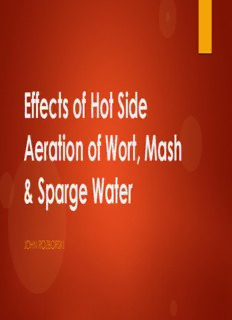
Effects of Hot Side Aeration PDF
Preview Effects of Hot Side Aeration
Effects of Hot Side Aeration of Wort, Mash & Sparge Water JOHN ROZBORSKI Hot Side Aeration HSA - Hot Side Aeration A generally accepted definition The introduction of O2 into hot wort. The O2 may bind with compounds in the wort, it is generally believed these oxidized compounds can break down over time and result in staling effects – namely off flavors and aromas. The most common perception is that HSA can occur during the transfer of hot wort from the mash tun to the boil kettle Which is why brewers use submerged hoses or feed lines to avoid cascading hot wort into the boil kettle. George Fix wrote in the Winter 1992 edition of Zymurgy magazine that Coors changed brewing equipment standards by implementing bottom feed lines to all of their boil kettles, and attributed this modification to the prevention of HSA and the desire to avoid staling.1 What is Staling? The perceived degradation of beer over time, which is accelerated with thermal cycling.2 Two forms of staling: Increasing compounds the formation of compounds typically associated with carbonyls Common carbonyl compounds in beer are: Acetaldehyde, furfural, asstd methylpropanals and methylbutanals, and nonenal.2 Decreasing compounds the reduction of compounds, perhaps the most common is hop aromatics, which tend to diminish over time. S. A Depraetere, et al, described their findings on the staling or aging of beers as following these sensory patterns: “Beers become sweeter, less bitter, less fruity and hoppy. In addition, pungent taste increased, together with a complex aroma, consisting of solvent, papery/cardboard, ribes, Madeira, caramel and sulfuric ageing notes”2 These observations were made during an aging study on pilsners and ales. Dark malt beers have staling flavors that can be different than those associated with pale beers. Some of the descriptors of staleness in dark or strong beers are Sherry-like, tomato, briny and black olives. While enjoying a beautiful day of brewing I checked my sparge level and saw this… Sparge water is quickly incorporated into the mash bed and then mixed into the wort. If this sparge water was highly aerated, could this “aerated sparge” also be capable of creating oxidized compounds that would lead to stale beer? My conundrum: If aerating hot wort is bad, couldn’t a vigorous sparge also be bad? If free O2 binds with compounds in wort, when the wort is aerated, then shouldn’t those same compounds bind with soluble O2 present in sparge water that blends with the wort? The Brew Community says: • HSA is real, Sparge Blogs, aeration is not a Forums, problem. Friends& • Neither HSA nor sparge aeration are problems. Fish • Don’t worry about it Conflicting & confusing responses
Description: